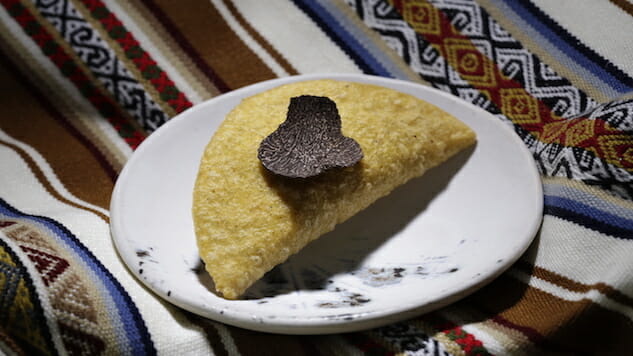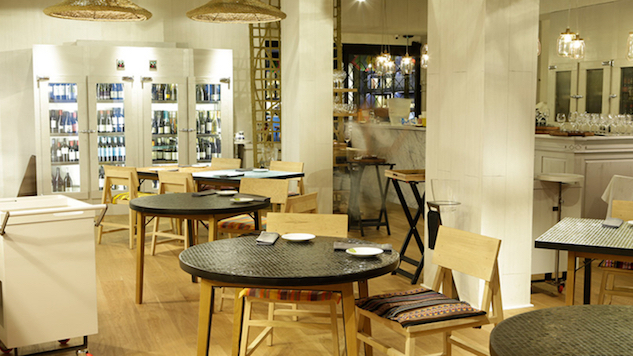
A jet-set lifestyle doesn’t have to be all private planes and decadent digs. In our Jet-Set Bohemian series, we blend the best of high and low for just the right balance … enticing everyone from backpackers to luxury boutique hotel lovers to come along for the ride.
![]()
While preparing my restaurant list for a recent trip to Barcelona, a chef friend of mine in Monaco asked if I had tried Hoja Santa. One of the harder to get into restaurants in town, the Mexican-inspired spot is part of award-winning Chef Albert Adrià’s (of the now-closed legendary El Bulli) elite circle of eateries in Barcelona. “They’re usually booked out a while in advance, but I’ll see if they can squeeze you in,” she said.
When El Bulli closed in 2011, Adrià made his way to Mexico City and started cooking in the same style that made his name famous in the culinary world, but this time applying these techniques to Mexican dishes instead of Spanish ones. The concept for two-year-old Hoja Santa came together not long after, when the chef made his way to Oaxaca with another El Bulli alum, Mexico City native Paco Méndez, now head chef at Hoja Santa.
Sitting in the airy dining room at Hoja Santa, it’s not hard to see the impact this country and its cuisine had on the chef. It’s the country’s traditional flavors and ingredients that make even the most notorious of chefs fall weak in the knees. The namesake sacred herb (a heart-shaped leaf native to Mexico) is served in a fusion of forms, starting with the whimsical amuse-bouche constructed from dehydrated vegetables, forming a paper-thin “chip” (shaped as the leaf) perched in a bed of branches. And that’s just the start to the 20-course tasting through the Mexican tapas-style menu.
 Photo courtesy of Hoja Santa
Photo courtesy of Hoja Santa
Adrià’s not the only one who seems to have struck up a love affair with this ancient cuisine. Award-winning chefs across the globe are looking to Mexico for their latest bout of inspiration, turning traditional recipes on their head for a more whimsical style of fine dining (Michelin star included).
In the swanky neighborhood of Salamanca in Madrid, Mexico City-born chef Roberto Ruiz is the man behind Punto MX, the first Mexican eatery to receive a Michelin star. Ruiz plays up his native flavors grown in the restaurant’s organic vegetable garden, with 27 different ingredients from habanero chiles to huauzontles, all brought over from Mexico. The five-year-old restaurant is also the only one in Spain that uses nixtamalization, the process of soaking corn in an alkaline solution, to craft tortilla mass the traditional way.
The menu here adds gastronomic flair to traditional Mexican cuisine with options like braised duck enchilada topped with squash seed green salsa and bone-marrow charbroiled in an ember oven, served alongside crushed roasted tomato salsa. And for those looking to try something with a more localized spin, there’s the Ibérico lean pork-filled Pastor tacos. Food here, though, is just half the equation. Punto MX also partners with sustainable small farms in Mexico to source its extensive mescal collection, with over 30 different types served up in Spain’s first Mezcal Lab. This more turned-down space is designed around the drinks, with mezcal and tequila served straight up or in cocktail form, and a menu of gourmet bar snacks that take their cue from some of the Punto MX’s best, such as the namesake guacamole.
 Photo courtesy of Kyle John
Photo courtesy of Kyle John
Touted as one of the world’s best restaurants, Copenhagen’s two Michelin-star Noma, which put Nordic cuisine on the global food map, is shutting its doors once again this spring in April for a seven-week pop-up in Tulum. Tickets for tasting menus—which cost a cool $600 per person—sold out in three and a half hours.
After nearly a decade of travel to Mexico, the country’s cuisine has already seeped its way into some of Chef René Redzepi’s dishes at Noma. Now the chef and his team have spent the past six months scouring Mexico in search of specific ingredients from seafood to the perfect spicy chile that will come together at the open-air eatery by the sea in a series of dishes derived from Mexican tradition—all cooked over an open flame.
 Photo courtesy of Kyle John
Photo courtesy of Kyle John
Redzepi will also partner with Noma’s former pastry chef, Rosio Sanchez, and her Copenhagen-based taqueria, Hija de Sanchez. The Chicago-born chef is a first generation Mexican-American whose goal was to cook up some of the best tacos in Europe with the use of corn, dried chile and spices—all hailing from Mexico—that form the key ingredients for the taqueria’s homemade masa (flour used to make tortillas) and salsa. While recipes for taco fillings stem from traditional dishes like pork carnitas and breakfast fave huevos rancheros, the taqueria also weaves in seasonal Scandinavian ingredients like gooseberry salsa and fried Fjord shrimp.
Sanchez got her start in high-end eateries like New York’s WD-50 before working her way up at Noma, but the concept behind Hija de Sanchez is just as much about quality cuisine as it is about making these Mexican dishes available to the public in one of the most accessible ways possible—with a stand at Copenhagen’s largest covered market, Torvehallerne. And while the menu veers on street food-style fare, the pastry chef still weaves in elements from her gastronomic past with homemade paletas, or ice pops, in flavors like tres leches and hibiscus tea, delicately topped with freeze-dried raspberries, candied cacao nibs and a strip of chili powder running up the sides.
Lane Nieset is Paste’s Jet-Set Bohemian columnist and a freelance writer covering all things travel from her home base in Nice, France.